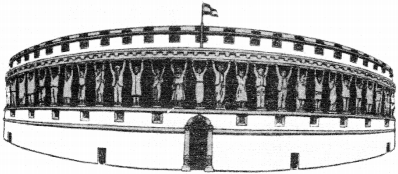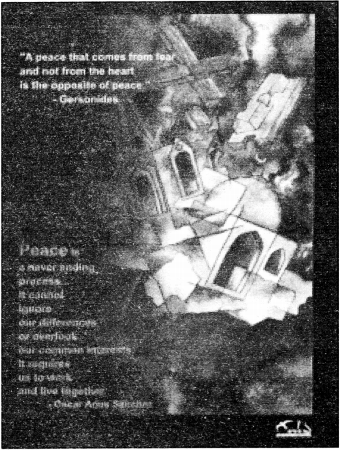Why Do We Need a Parliament Class 8 Questions and Answers Civics Chapter 3
Civics Class 8 Chapter 3 NCERT Textbook Questions and Answers
Observe the image of the Parliament and answer the following questions :

Question 1.
What do you think the artist is trying to convey though the image of Parliament?
Answer:
The image portrays that the Indian Parliament is based on the people’s strength and these people come from various religious and back grounds.
Question 2.
Give one reason why you think that there should be universal adult franchise.
Answer:
These should be universal adult franchise in order to establish equality in the society and give everyone the opportunity to vote.
Question 3.
Do you think there would be any difference of the class monitor was selected by the teacher or elected by the students? Discuss.
Answer:
A teacher selecting a class monitor is not a democratic process. The selected monitor by the teacher is not a representative of the students of the class. However, if the monitor is elected by the students it will be a democratic process and the monitor will be the representative of the whole class.
Look at the table given and answer the questions that follow :
Results of 8th Lok Sabha Elections (1984)
| Political Party | No. of MPs elected |
| National Parties Bharatiya Janta Party (BJP) |
2 |
| Communist Party of India (CPI) | 6 |
| Communist Party of India (Marxist) (CPM) | 22 |
| Indian Congress Socialist (ICS) | 4 |
| Indian National Congress (INC) | 404 |
| Janata Party (JNP) | 10 |
| Lok Dal (LKD) | 3 |
| State Parties
All India Anna DMK (AIADMK) |
12 |
| Dravida Munnetra Kazhagam (DMK) | 2 |
| All India Forward Block (FBL) | 2 |
| Indian Congress (J) (ICJ) | 1 |
| Jammu & Kashmir Conference (JKC) | 3 |
| Kerala Congress (J) (KCJ) | 2 |
| Muslim League (MUL) | 2 |
| Peasants and Workers Party of India (PWP) | 1 |
| Revolutionary Socialist Party (RSP) | 3 |
| Telugu Desam Party (TDP) | 30 |
| Independents | 5 |
| Grand Total | 514 |
Note : The Lok Sabha elections were not held in Assam and Punjab during 1984.
Question 4.
(a) Who will form the government? Why?
(b) Who will be present for discussions in the Lok Sabha?
(c) In this process similar to what you have read in class VII?
Answer:
(a) The Indian National Congress (INC) will form the government because it has secured clear majority in the Lok Sabha.
(b) All the MPs
(c) Yes.
Question 5.
Look at the picture given on next page. It shows results from the 3rd Lok Sabha election held in 1962. Use the photograph to answer the following questions.

1) Which state has the highest number of MPs in the Lok Sabha? Why do you think this is so?
2) Which state has the least number of MPs in the Lok Sabha.
3) Which political party has won the most seats in all states?
4) Which party do you think will form the government? Give reasons why.
Answer:
- Uttar Pradesh. This state has the largest population as compared to other states. Thus, it has the highest number of MPs in the Lok Sabha.
- Manipur.
- The Congress Party
- The Congress Party will form the government because it has got clear majority in the Lok Sabha.
Question 6.
The following is an example of a question asked in the Parliament.
LOK SABHA
UNSTARRED QUESTION NO 2007 ANSWERED ON 30.11.2007
JUNK FOOD IN SCHOOLS
2007. SHRI SALARAPATTY KUPPUSAMY KHARVENTHAN
Will the Minister of WOMEN AND CHILD DEVELOPMENT be pleased to state :
(a) whether the National Commission for Protection of Child Right (NCPCR) has asked all State Governments to ban junk foods in schools and also for setting up of nutrition standards;
(b) If so, the details thereof;
(c) Whether the Union Government has ensured the compliance of the above standards by the States; and
(d) If so, the details thereof
Answer:
THE MINISTER OF STATE OF MINISTRY OF THE WOMEN AND CHILD DEVELOPMENT
(a) and (b) No, Sir, A letter was issued to the States by National Commission for protection of Child Right (NCPCR) to consider providing guidelines to schools to create a school nutrition policy.
(c) and (d) Does not arise.
Question 7.
(a) In the above questions, what information is being sought from the Minister of Women and Child Development?
(b) If you a Member of Parliament (MP), list two questions that you would like to ask?
Answer:
(a) The information sought from the Minister of Women and Child Development is as follows :
- Whether the National Commission for protection of Child Rights (NCPCR) has asked all the State Governments for a ban of junk foods in schools and for setting up nutrition standards in school. If so, the details there of.
- Whether the Union Government has assured the compliance of the above standards by the states. If so, the details there of.
(b) If I were a Minister of Parliament, I would ask the following question :
What steps has the government taken to ensure education to every child? Why is the government not giving equal status to women?
Question 8.
Looking at this table would you say that people’s participating the past 50 years has : decreased / increased / been stable after initial increase?
| Lok Sabha | Election Year | Voter Turnout (%) |
| 1st | 1951-52 | 44.87 |
| 4th | 1967 | 61.04 |
| 5th | 1971 | 55.27 |
| 6th | 1977 | 60.49 |
| 8th | 1984 | 63.56 |
| 10th | 1991 | 56.73 |
| 14th | 2004 | 58.07 |
Answer:
The people’s participation during the past 50 years is not stable. It is fluctuating from one election to another.
Question 9.
Why do you think there are so few women in parliament? Discuss.
Answer:
In India we still have a male-dominating society. People still do not want women to rule the country. For this reason they avoid giving powrer to the women.
Question 10.
Why do you think the nationalist movement supported the idea that all adults have a right to vote?
Answer:
The nationalist movement became successful only by the participation of people from all sections of society. With the coming of independence, it was felt that people from all sections of society should be allowed to vote in independent India. The government can only function properly if as it is sensitive to the demands and needs of the people. Thus, in the constitution of independent India, the first provision was the principle of universal adult franchise i.e., all adult citizens of the country have a right to vote. By providing this right adult people of all caste, religious sex, etc. would participate in the functioning of the government through their representative. This is true democracy.
Question 11.
In this 2004 map of Parliamentary constituencies alongside, roughly identify the constituencies in your State. What is the name of the MP from your constituency? How many MPs does your state have? Why are certain constituencies coloured green while others are coloured blue?
Answer:
I live in the State of Delhi. The total number of the constituencies is 7. They are as following :
- East Delhi
- Chandni Chowk
- North-East Delhi
- New Delhi
- North-West Delhi
- West Delhi
- South Delhi.
Question 12.
You have read in chapter 1 that the ‘Parliamentary form of government’ that exists in India has three tiers. This indudes the parliament (central government) and the various state legislatures (state government). Fill in the following table with information on the various representative from your area :
| State Government | Central Government | |
| Which political party/parties is/are currently in power? | ||
| Who (name) is the current representative from your area? | ||
| Which political parties currently form the opposition? | ||
| When were elections last held? | ||
| When will the next elections be held? | ||
| How many women representatives are there (from your state)? |
Answer:
| State Government | Central Government | |
| Which political party/parties is/are currently in power? | Congress | UPA (United Progressive Alliance)
It is a coalition govt. |
| Who (name) is the current representative from your area? | Mr. Ashok Kumar Walia | Mr. Sandeep Dixit |
| Which political parties currently form the opposition? | BJP | NDA, BSP, CPH, BJP, etc. |
| When were elections last held? | 2008 | 2009 |
| When will the next elections be held? | 2013 | 2014 |
| How many women representatives are there (from your state)? | 4 | 1 |
Note : You can take help of your teacher or parents to write the information related to above of your area.The above matter given is a sample solution for NCT Delhi (East Delhi parliamentary constituency).